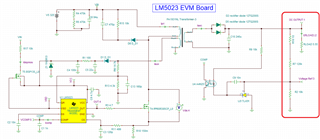Other Parts Discussed in Thread: LMV431, LM5023, TL431, TL432
Hello,
I am working with a design similar to the LM5023 65W Evaluation Board. In this design I had changed the shunt voltage regulator from LMV431 (ref voltage: 1.25V) to TL431 (ref voltage: 2.5V). Keeping other components same as recommended in Evaluation Board.
For 19V output, I had used the potential divider circuit with resistances of 120kOhm and 18kOhm to provide around 2.5V at reference pin of TL431 as shown in following figure.

The tina simulation runs fine as expected and 2.49V is obtained at reference voltage pin as shown in following figure.

But when this same circuit is applied on PCB, then the output voltage is regulating at 3.8V instead of 19V. Even the voltage at voltage reference pin of TL431 comes around 1.8V instead of 2.5V.
My plant side is working fine when I checked the converter by providing the fixed duty externally to the gate of mosfet. The problem may be on feedback loop.
Kindly help me with this issue.
Regards,
Raj

